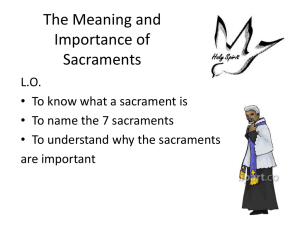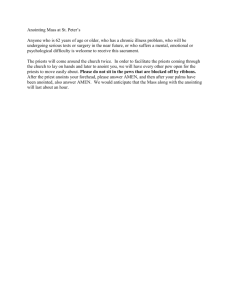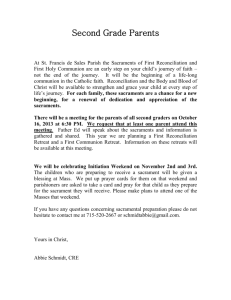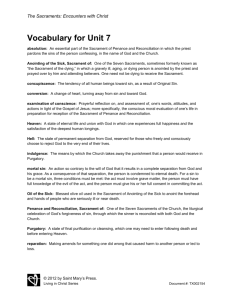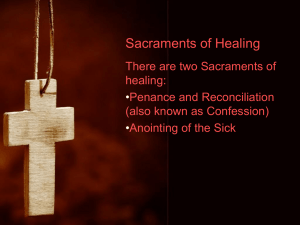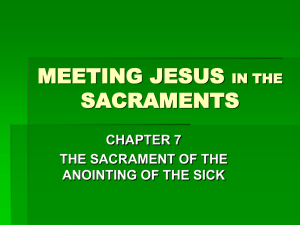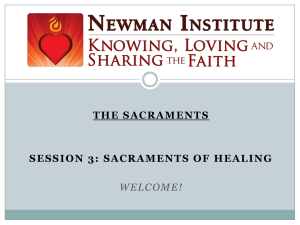Unit 6.7 - We Celebrate The Sacraments Part II
advertisement
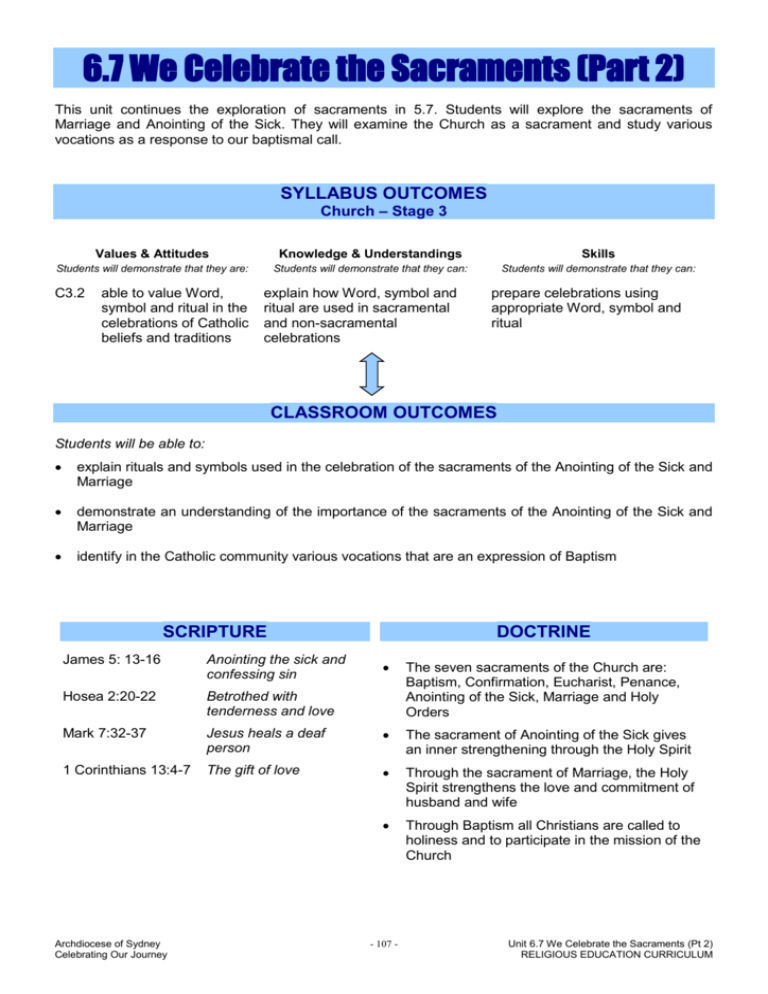
6.7 We Celebrate the Sacraments (Part 2) This unit continues the exploration of sacraments in 5.7. Students will explore the sacraments of Marriage and Anointing of the Sick. They will examine the Church as a sacrament and study various vocations as a response to our baptismal call. SYLLABUS OUTCOMES Church – Stage 3 Values & Attitudes Knowledge & Understandings Skills Students will demonstrate that they are: Students will demonstrate that they can: Students will demonstrate that they can: C3.2 able to value Word, symbol and ritual in the celebrations of Catholic beliefs and traditions explain how Word, symbol and ritual are used in sacramental and non-sacramental celebrations prepare celebrations using appropriate Word, symbol and ritual CLASSROOM OUTCOMES Students will be able to: explain rituals and symbols used in the celebration of the sacraments of the Anointing of the Sick and Marriage demonstrate an understanding of the importance of the sacraments of the Anointing of the Sick and Marriage identify in the Catholic community various vocations that are an expression of Baptism SCRIPTURE James 5: 13-16 Anointing the sick and confessing sin Hosea 2:20-22 Betrothed with tenderness and love Mark 7:32-37 1 Corinthians 13:4-7 Archdiocese of Sydney Celebrating Our Journey DOCTRINE The seven sacraments of the Church are: Baptism, Confirmation, Eucharist, Penance, Anointing of the Sick, Marriage and Holy Orders Jesus heals a deaf person The sacrament of Anointing of the Sick gives an inner strengthening through the Holy Spirit The gift of love Through the sacrament of Marriage, the Holy Spirit strengthens the love and commitment of husband and wife Through Baptism all Christians are called to holiness and to participate in the mission of the Church - 107 - Unit 6.7 We Celebrate the Sacraments (Pt 2) RELIGIOUS EDUCATION CURRICULUM SPIRITUAL REFLECTION FOR TEACHERS Hands! A gentle hand, a touch of support, an embrace. Signs of relationship. “We will hold hands,” Morrie said, “And there’ll be a lot of love passing between us. Ted, we’ve had thirty-five years of friendship. You don’t need speech or hearing to feel that.” (Tuesdays With Morrie by Mitch Albom, Hodder, 1998, p71) Relationships can be a sacrament (visible sign of God). Within relationship we give and receive. We care for each other in times of crisis and brokenness. We are signs of love for each other. - Who is the person (or people) with whom you have the closest relationship? - Who draws you out of yourself, to be ‘Christ’ in the world? - How do you depend on God? CATECHISM OF THE CATHOLIC CHURCH Excerpts from the Catechism of the Catholic Church are included below as information for teachers. They present the Church’s teachings contained in this unit. 3 Those who with God's help have welcomed Christ's call and freely responded to it are urged on by love of Christ to proclaim the Good News everywhere in the world. This treasure, received from the apostles, has been faithfully guarded by their successors. All Christ's faithful are called to hand it on from generation to generation, by professing the faith, by living it in fraternal sharing, and by celebrating it in liturgy and prayer. 780 The Church in this world is the sacrament of salvation, the sign and the instrument of the communion of God and men. 1131 The sacraments are efficacious signs of grace, instituted by Christ and entrusted to the Church, by which divine life is dispensed to us. The visible rites by which the sacraments are celebrated signify and make present the graces proper to each sacrament. They bear fruit in those who receive them with the required dispositions. 1210 Christ instituted the sacraments of the new law. There are seven: Baptism, Confirmation (or Chrismation), the Eucharist, Penance, the Anointing of the Sick, Holy Orders and Matrimony. The seven sacraments touch all the stages and all the important moments of Christian life: they give birth and increase, healing and mission to the Christian's life of faith. There is thus a certain resemblance between the stages of natural life and the stages of the spiritual life. 1532 The special grace of the sacrament of the Anointing of the Sick has as its effects: the uniting of the sick person to the passion of Christ, for his own good and that of the whole Church; the strengthening, peace, and courage to endure in a Christian manner the sufferings of illness or old age; the forgiveness of sins, if the sick person was not able to obtain it through the sacrament of Penance; the restoration of health, if it is conducive to the salvation of his soul; the preparation for passing over to eternal life. 1661 The sacrament of Matrimony signifies the union of Christ and the Church. It gives spouses the grace to love each other with the love with which Christ has loved his Church; the grace of the sacrament thus perfects the human love of the spouses, strengthens their indissoluble unity, and sanctifies them on the way to eternal life (cf Council of Trent: DS 1799). Archdiocese of Sydney Celebrating Our Journey - 108 - Unit 6.7 We Celebrate the Sacraments (Pt 2) RELIGIOUS EDUCATION CURRICULUM SCRIPTURE: BACKGROUND INFORMATION Mark 7: 32-37 Jesus heals a deaf person This incident is recorded only in Mark and occurs in Gentile territory. In locating the incident here Mark may have been acknowledging the Church’s mission to Gentiles, to no- Jewish peoples. Jesus reaches out to heal one suffering from deafness and a speech impediment. He takes the man away from the crowd and lays his hands upon him. Following this act the man’s hearing and speech are restored. In asking the healed man to keep this event to himself, Mark is indicating that Jesus is much more than simply a healer of physical ailments. It is also a warning that excessive attention might frustrate his ministry. The man ignores this instruction and proceeds to proclaim Jesus’ mission, in contrast to those who have followed Jesus, who have heard his words, and yet have not listened to his message. Here the onlookers clearly witness the physical cure and this serves to highlight the true nature of Jesus’ identity.1 James 5:13-16 Anointing the sick and confessing sin Ultimately the text is about prayer, which is a major part of our sacraments. Anointing of the sick incorporates the healing properties of oil as well as prayer. The sacraments in their present form have taken many centuries to develop. While the biblical texts underpin and give essential meaning to our sacramental theology, they do not record the rites as we celebrate them today. Hosea 2:20-22 Betrothed with tenderness and love The prophet Hosea uses the image of married love to describe the love of God for people. These beautifully descriptive words may be used also to describe the ideals of married love. A love that is in harmony with all creation. A love that is leavened with integrity, that is just, tender and faithful. A love that reflects the love of God and makes the world a better place simply by its presence. The words of Hosea represent the spirituality of the sacrament of marriage very accurately. Through this sacrament and their love, couples “come to know God” (verse 22). 1 Corinthians 13:4-7 The gift of love 1 Corinthians 13 focusses on love and addresses the needs of the Corinthian church. It is written in prose rather than verse but nevertheless has poetic qualities both in the level of language and its structure.2 In verses 1-3, immediately before this section (vs 4-7), we have three conditional statements all constructed on the same model. In each case spiritual charisms or gifts mentioned from the previous chapter (12) are presented, and despite the quality of the gifts and how well they are used, each is pronounced as worthless unless there is love. In vs 4-7 Paul personifies love and how ‘it’ behaves in relation to others. A number of simple verbs and statements tell us what love is and also what it is not. It begins by naming two positive virtues and then proceeds with a list of negative qualities evident in the Corinthian Church. The emphasis is on what is done or not done to another. The love of which Paul is speaking is ‘agape’ or sacrificial love, love that does not count the cost but rather, “it bears all things, believes all things, hopes all things, endures all things” (vs7). 1 KWL, Teaching Companion, 4b, p 199 2 Barton J, Muddiman J (Ed), The Oxford Bible Commentary Oxford University Press p.1128, 2001 Archdiocese of Sydney Celebrating Our Journey - 109 - Unit 6.7 We Celebrate the Sacraments (Pt 2) RELIGIOUS EDUCATION CURRICULUM THE CHURCH’S TEACHING AND LIVED TRADITION In Tradition: To Know, Worship and Love Year 6, p144 - Marriage Vows In the celebration of a Catholic marriage many elements are emphasised. The first is the liturgy of the Word, which highlights the significance of the Christian marriage and the couple’s duties and responsibilities towards each other and any children they may have as a result of their union. The couple exchange vows to love and honour each other unconditionally throughout their married life together. They enter into a covenant with each other. Hence they become a sign of the covenant relationship between Christ and the Church.3 In Tradition: To Know, Worship and Love Year 6, p152 -The Sacrament of Anointing As followers of Jesus we, his Church, are missioned to continue his healing work through the Sacraments of Penance and Anointing of the Sick. In the latter, the priest prays that the sick person receive the strength and peace of the Holy Spirit. The priest places his hands on the sick person’s head and anoints the forehead and hands with the Sign of the Cross, saying: Through this holy anointing may the Lord in his love and mercy help you with the grace of the Holy Spirit. Amen. May the Lord who frees you from sin save you and raise you up. Amen. “The Sacrament of Anointing of the Sick prolongs the concern which the Lord himself showed for the bodily and spiritual welfare of the sick, as the Gospels testify, and which he asked his followers to show also … “The Celebration of this Sacrament consists especially in the laying on of hands by the presbyters of the Church, their offering the prayer of faith, and the anointing of the sick with oil made holy by God’s blessing. This rite signifies the grace of the sacrament and confers it”. From: Rite of Anointing and Pastoral Care of the Sick, par5.4 3 4 KWL, Teaching Companion, 4b, p190 KWL, Teaching Companion, 4b, p200 Archdiocese of Sydney Celebrating Our Journey - 110 - Unit 6.7 We Celebrate the Sacraments (Pt 2) RELIGIOUS EDUCATION CURRICULUM CELEBRATION: PRAYER AND LITURGY Celebration is a key part of Religious Education. The following suggestions provide opportunities throughout the unit for celebration in prayer and liturgy. Most of these suggestions are included as ‘teaching/learning’ activities in Unit Content sections. Use Mark 7:32-37 in a Guided Meditation (Resource Sheet 1). Prayer Service: Set up a sacred space with symbols from the sacrament of Anointing of the Sick. Sing a hymn about healing. Use James 5:13-15 as a reading, read a few of the students poems and prayers, pray the prayer in KWL p152 laying hands on one another. End with a prayer of blessing and a thanksgiving hymn. Prayer celebration thanking God for God’s faithfulness and love as seen in Hosea. Thank God for our relationships - all types of relationships. Plan and celebrate a Liturgy of the Word. Choose an appropriate reading: Jn 13:34 or Galatians 3:26-29. Renew baptismal promises and pray prayers of thanksgiving for different vocations within the Church. Ask God for support as you choose/live your vocation within the Catholic Church. ASSESSMENT Interim Assessment Statement 2014 The identification of Teaching/Learning strategies as ‘suggested assessment’ has been removed from the 3-6 RE curriculum. The type of assessment activity and the way evidence of learning is gathered will vary, depending on such factors as; the outcomes being assessed, the evidence being gathered, the teaching and learning activity, context and students’ learning needs (NSW Board of Studies, http://syllabus.bos.nsw.edu.au/support-materials/k-6-assessment-strategies/) . Assessment in Religious Education is based on the same principles as in other key learning areas. Please refer to the CEO Sydney site supporting the implementation of the Australian Curriculum in the context of the NSW BOS Syllabus. At this site https://sites.google.com/a/syd.catholic.edu.au/professional-learning-modules/home professional learning modules are provided to support teachers as they engage with the NSW BOS Syllabuses for the Australian Curriculum. Module 4, Assessment and Planning explores the principles of effective assessment for, as and of learning and considers a range of strategies and methods for assessing student learning. Activities focus on moving beyond assessment as an index of learning, towards assessment that motivates, enhances learning and achieves deeper understanding to meet the diverse learning needs of all as students. Participants are encouraged to reflect on assessment as a driver for improvement in teaching and learning. Religious Education Curriculum and Assessment In Year 3-6 Religious Education Curriculum, both Syllabus Outcomes and Classroom Outcomes are key reference points for decisions about students’ progress and achievement. Classroom outcomes are more specific to the unit content. Unit Content statement and Students will learn statements in each unit should also be taken into account in planning and developing learning and assessment opportunities. Outcomes and Unit Content Statements are derived from Syllabus objectives. Effective Religious Education involves teaching the Catholic faith (Scripture, doctrine, traditions, prayer and sacraments) and nurturing the faith of the child. There is no attempt to assess the child’s faith. Assessment is concerned with skills, knowledge and understanding of the Catholic faith taught in the curriculum and supported in the religious life of the school. Archdiocese of Sydney Celebrating Our Journey - 111 - Unit 6.7 We Celebrate the Sacraments (Pt 2) RELIGIOUS EDUCATION CURRICULUM RESOURCES To Know Worship and Love - Year 6, Chapters 15 and 16, (2003), James Goold House Publications, Melbourne, Victoria Books The Rites, Vol 1 and 2, (1990), Pueblo Publishing Company, NY Liturgical Commission, (1985), When We Marry, Brisbane, Qld Ryan M, (1999), Sacraments of Healing. Social Science Press, Australia Woods L, (1999), A Dictionary For Catholics, HarperCollins, Victoria Websites http://www.catholicozvocations.org.au (National vocations website) http://www.catholicvocation.org.au (Vocation website for the diocese of Melbourne) http://www.catholicvocation.org.au/cv_reflectioncommittedsinglelife1.html KEY TO SYMBOL denotes higher order activity Archdiocese of Sydney Celebrating Our Journey - 112 - Unit 6.7 We Celebrate the Sacraments (Pt 2) RELIGIOUS EDUCATION CURRICULUM UNIT CONTENT 1 The Catholic Church celebrates the Anointing of the Sick as a sacrament of healing. Students will learn: about the rituals in the Sacrament of the Anointing of the Sick about the significance of the Sacrament of the Anointing of the Sick in the life of the Church Unit Content: Background Information In 5.7 students explored the sacrament of Penance. Now they explore the other sacrament of healing: Anointing of the Sick. Begin the unit by directing students to recall what they learned about sacraments in previous years and units. Then briefly review the sacraments of healing. Throughout the history of the Church there has been some form of laying on of hands and anointing, which shows a concern for those who are sick or dying. Like all sacraments, Anointing of the Sick has moved through a long history of development and change. This sacrament was only administered to those who were dying for many centuries, hence the term ‘last rites’. Since the Second Vatican Council it has been restored to its rightful place as a sacrament for all who are seriously sick and need healing. The sacrament of the Anointing of the Sick is for the seriously sick, the elderly who have become noticeably weakened or frail, and those who are dying. It is celebrated within a community and can be received more than once. The sacrament of Anointing of the Sick gives strength, comfort and courage to the sick person, brings physical and spiritual healing and forgives sins. It is important to note that healing does not mean a magical cure of the sick person. The two main symbols and rituals in this sacrament come from ancient times (the Old Testament tradition). Laying on of hands symbolises the calling of the Holy Spirit. It is done in silence, followed by the prayer calling on the Holy Spirit. Anointing with oil is a sign of the grace of the Holy Spirit giving strength, courage and peace. It is useful to connect this sacrament to the many ministries and apostolates of the Church, for the sick, elderly and dying. Suggested Teaching/Learning Strategies Introduce the first doctrine about the seven sacraments. Review what students know about sacraments in general from previous years. Name the seven sacraments and recall what the students know about them. Categorise them into the 3 main groups. Organise this information on a matrix. Introduce this unit: ‘Marriage’ and ‘Anointing of the sick’. Collect media articles that focus on human suffering in its many forms. Share your findings in small groups. Decide together what you feel are the common themes or factors. Classify different forms of human suffering you have encountered (eg physical/spiritual) and display your ideas.5 Recall and reflect on experiences of sickness. Role-play some of these experiences. Ask students to brainstorm ways in which the Christian community can show real concern and care for those who are sick or frail.6 Tell the liturgical story of the ‘Anointing of the Sick’ using suggested script and 2D & 3D materials. See Resource Sheet 1. 5 6 KWL, Teaching Companion, 4b, p201 ibid Archdiocese of Sydney Celebrating Our Journey - 113 - Unit 6.7 We Celebrate the Sacraments (Pt 2) RELIGIOUS EDUCATION CURRICULUM Engage students in wondering using your own or the suggested wondering statements below. - I wonder whether you’ve seen someone receive the Sacrament of Anointing of the Sick. I wonder why the priest lays his hands on the sick person. I wonder why the priest anoints the sick person with oil. I wonder how the sick person might feel when he or she receives this sacrament. Students are given the opportunity to illustrate, paint or write about a part of the story, ‘Anointing of the Sick’. Students are also given the opportunity to use the materials to retell the story. Read together Anointing of the Sick from KWL Year 6, p149-150. What do you think are the key points in this passage, about this sacrament? What do you think is an important message about this sacrament?7 Read the account of the Anointing of the Sick in Living the Gospel, KWL Year 6, p 153. Compare this account with the elements of the sacrament outlined in ‘In Tradition’, KWL Year 6, p152. Are the elements the same? If not, why do you think there are differences? Jesus’ Ministry of Healings Students recall and list stories of Jesus healing people. Dramatise a favourite healing story of Jesus. Create a ‘sound-scape’ to highlight and emphasise key moments in the drama (eg crowd noises, wind, appropriate music …). Discuss the different forms of healing that occurred and the fact that the healing given was sometimes more than physical. Choose a song that communicates Jesus’ ministry of healing. On a map of Palestine in the time of Jesus, locate the area in which the healing of the deaf man occurred in Mark’s account. 8 Students read Mk 7:32-37 briefly. Use the passage in a Guided Meditation (see Resource Sheet 2). Find out about different ways that special oils have been used for anointing throughout history. Listen to the words of James 5:13–15. - According to James (in this passage) what must be done for sick people? Why did the early Christian communities use oil (olive oil)? What does the praying and anointing with oil do for the sick person? Describe what James is asking of his disciples. Match aspects of James’ letter with the sacrament of Anointing of the Sick. The Church and The Healing Ministry Find out about the ways your parish community ministers to the sick. Invite the priest or a parishioner to speak to the students about how the parish cares for the sick. (Some examples may be administering this sacrament, communion to the sick, and visitation…). Design a poster or pamphlet to promote this ministry in the parish. Alternatively, invite a hospital chaplain or pastoral care worker to speak to the class. Visit your local church to view and discuss the holy oils and how they are used in the rituals of our Church community. Read ‘Our Heritage’, KWL Year 6, p154 (link this to Confirmation).9 Introduce doctrine about Anointing of the Sick. Explore the Rite of the Sacrament of Anointing of the Sick (see The Rites 1). Students explore the significance of the symbols, rituals and prayers of the sacrament. 7 ibid ibid 9 KWL, Teaching Companion, 4b, p202 8 Archdiocese of Sydney Celebrating Our Journey - 114 - Unit 6.7 We Celebrate the Sacraments (Pt 2) RELIGIOUS EDUCATION CURRICULUM Organise a group visit to the sick in a local hospital with a member of your parish’s hospital visitation team. Another possibility might be to actually participate in a Mass of Healing in the parish church, and helping to plan and prepare elements of the celebration.10 Plan and organise a visit to the sick or elderly at a local facility. Prepare letters or cards of support and encouragement, or make small gifts to accompany the visit.11 - Write a poem, prayer or a song about the healing power of Jesus in your life, or about one of the Gospel healing stories with which you are familiar.12 Organise and celebrate with students a liturgy: Set up a sacred space with symbols of the sacrament (or appropriate symbols). Sing a hymn about healing. Proclaim James 5:13-15 as the reading. Read a few of the students’ poems and prayers from the above activity, and pray the prayer in KWL, p152 laying hands on one another. End with a blessing and/or thanksgiving hymn. Briefly describe the Sacrament of Anointing of the Sick and its importance in the life of the Church. Include some of the major symbols and rituals used. Students give a creative presentation, e.g. written explanation, a short assignment or presentation using ICT. 10 KWL, Teaching Companion, 4b, p203 ibid 12 KWL, Teaching Companion, 4b, p203 11 Archdiocese of Sydney Celebrating Our Journey - 115 - Unit 6.7 We Celebrate the Sacraments (Pt 2) RELIGIOUS EDUCATION CURRICULUM UNIT CONTENT 2 The Catholic Church celebrates Marriage as a sacrament at the service of communion. Students will learn: about the rituals in the Sacrament of Marriage about the significance of the Sacrament of Marriage in the life of the Church Unit Content: Background Information In 5.7 students explored the sacrament of Holy Orders. Now they explore the other sacrament at the service of communion: Marriage. Briefly review what students know about the sacraments at the service of communion. The sacraments of Marriage and Holy Orders are no longer referred to as the Sacraments of Vocation. They are sacraments ‘at the service of communion’ or ‘in the service of community’. The two names are interchangable. Central to exploring marriage is our covenant relationship with God. Marriage is a covenant between the couple. The prophet Hosea demonstrates clearly the link between marriage and covenant. God calls us to relationship and God remains faithful to that relationship. In sacred Scripture we see the continuous faithfulness of God in the history of Israel. The people of Israel continuously break the covenant and are called back by God, the faithful one. The same covenant (and the same dynamic) exists today between God and people. Marriage symbolises this covenant relationship with God as it is a sign of the life of communion the Church is called to be. Marriage also symbolises the sacramentality of all right relationships; as human love and friendship can be sacramental signs. Like all covenants, marriage is permanent and is based on mutual fidelity. In exploring the sacrament of Marriage students need to look at relationships in general. How do students understand relationships and love? Healthy relationships occur when people give and receive of each other. There are times of challenge and times when all goes well. The media can be a powerful influence on students. It has many messages and images about love, relationships and human sexuality. These images and messages can be positive and/or negative. Explore what is being presented to students and encourage students to be critical of the images and message with which they are presented. An important question to consider is: do the media support or hinder a healthy understanding of love, relationships, sexuality and images of male and female persons? How do the media present or not present Christian values of love, relationship and the dignity of the person? In exploring the sacrament of Marriage, relationships and love in general, pastoral care and sensitivity are needed. Consider what are the marriage and family experiences of students. For questions and experiences about divorce, separation etc, see information in the Seasons for Growth Program. This unit is not the place to be making explicit or implicit judgments about relationships, marriage, separation and divorce. Suggested Teaching/Learning Strategies Read KWL Year 6, p141-143 ‘Marriage’. 1. Clarify and discuss information. 2. Recall a wedding that you or your students have attended. Share the experience with the class. (Students may want to bring in photos to show.) 3. Define words such as vows, covenant, dignity, respect and honour. Draw students’ attention to: Who is the minister in this sacrament? (bride and groom). What does this sacrament symbolise? 4. Design posters to illustrate some of the concepts you have discussed. Archdiocese of Sydney Celebrating Our Journey - 116 - Unit 6.7 We Celebrate the Sacraments (Pt 2) RELIGIOUS EDUCATION CURRICULUM - Media Search. How is marriage (and relationship) portrayed in the media? Research newspapers, magazines, television. What message do the media present about marriage and relationship? Collect photos and articles on marriage and relationship. What are some of the underlying themes attached to the idea of marriage and relationship in the world of media? Make a large class collage of words and photographs collected. Students can also write on sentence strips their responses to how the media reports on marriage. Read Hosea 2:19-23. - Who is Hosea? Give students some basic information about Hosea and his life (see Scripture background information). Explain to the students that Hosea’s marriage is an analogy of God’s relationship with Israel. - Read the Scripture passage. - To whom does ‘I’ refer in the reading? - What will the Lord do? Why do you think Hosea uses this imagery? Why is it important for rain to fall? - Is there any condition on this? Why not? (Notice that God does not place a condition on this covenant. God is ever faithful while Israel is often unfaithful to God). - What may this passage say about love? What may this passage say about marriage? What may this passage say about our relationship with God? - What is Hosea saying about the effects of right relationship? - Link this passage to marriage as a symbol of God’s relationship with the Church. - Prayer celebration thanking God for God’s faithfulness and love. Introduce doctrine on Marriage. Explore the Sacrament of Marriage. Read and discuss KWL Year 6 ‘In Tradition’, p144, ‘Our Heritage’ and ‘Did You Know’ p146-147. Ask your parish priest for the official book used in the Rite of Marriage or use The Rites or When We Marry (see Resources). Review the structure of the sacrament of Marriage (symbols, rituals, prayers…). Gather information about the sacrament of Marriage and create a retrieval chart. Two symbols of marriage are the couple sharing their life together and the community supporting them in their life together. Fold A4 paper into four and have the students illustrate two ways couples share their life together and two ways the Catholic community supports families. 13 Briefly describe the Sacrament of Marriage and its importance in the life of the Church. Include some of the major symbols and rituals used. Students give a creative presentation (written explanation, a short assignment or presentation using ICT). Complete a grid to summarise information on the sacraments of Marriage and Anointing of the Sick. Fill in parts of the grid and allow students to fill in the rest of the grid. 13 KWL, Teaching Companion, 4b, p173 Archdiocese of Sydney Celebrating Our Journey - 117 - Unit 6.7 We Celebrate the Sacraments (Pt 2) RELIGIOUS EDUCATION CURRICULUM UNIT CONTENT 3 As the Church, we are called to be a sacrament for the world. Students will learn: about Christian vocation as an expression of Baptism about different vocations in the life of the Church Unit Content: Background Information Through Baptism, and the sacraments of initiation, all Christians are called to holiness and participation in the life of the Church. A vocation is a calling (latin ‘vocatio’ means ‘a calling’). Christians are called to become Christ in the world, to participate with God’s Spirit to continue the mission of Jesus and build the Kingdom of God. How people do this becomes their vocation. Christians are called to the vocation that gives them fullness of life, so that in turn they give life to others. ‘I have come that you may have life, and have it to the full’ (John 10:10). A vocation involves both work or apostolate and presence. It is how we live and interact in the world. Central to a Christian vocation is the person’s relationship with God. In the past Marriage and Holy Orders were seen as the sacraments of vocation. While both Marriage and Holy Orders are vocations, they are two of various vocations in the Church. Baptism, Eucharist and Confirmation affirm our vocation to holiness and mission. While this Unit Content deals with vocations, it does not deal with sacraments explicitly. Vocations are not sacraments. However, it does explore the implications of the Sacraments of Initiation. Through Baptism we are called to holiness and to live out a vocation. Marriage and Holy Orders are already dealt with in this unit and in 5.7. This section deals with other Christian vocations. Through their choice of vocation, Christians make an effort to live lives of love for self, others and God. Hence vocations place us at the service of the community in some way and we become sacramental signs in the world. Many people in the Catholic Church live lives committed to Christian values and Church teachings through religious life, single life or as missionaries. These are a few of many vocations in the Church. Information on the websites in the resource list gives brief explanations on different vocations. For an explanation of single life see Teresa Pirola’s article on the single life: www.catholicvocation.org.au/cv_reflectioncommittedsinglelife1.html What other vocations are there? Often people speak about their vocation in terms of lifestyle and work/ministry. Both are interrelated. The question is: How can I best live a life of service to God? What can I do in service of the community? However, the emphasis is not in doing but being. Suggested Teaching/Learning Strategies Review what students know about Baptism. Link Baptism, call to holiness and fullness of life (link to Confirmation unit). 1 Cor 13:4-7 Love is … - What is Love? In pairs, students brainstorm endings to the sentence stem ‘Love is …’ Share ideas. - Read and discuss the Scripture passage. - From the passage list: Love is … and Love is not … Compare these lists with students’ brainstorms. - Who is called to love? As Christians who are we called to love? - Link Baptism and the call to holiness with love. Living the Gospel message is living a life of love. Define and discuss term ‘vocation’. What is a vocation? What is the difference between vocation and career? Archdiocese of Sydney Celebrating Our Journey - 118 - Unit 6.7 We Celebrate the Sacraments (Pt 2) RELIGIOUS EDUCATION CURRICULUM Explain to students that most people choose the vocation of marriage as an expression of love. Holy Orders (studied in Year 5) is another vocation that some choose. Students make a list of other Christian vocations. (They may need assistance from the teacher) Introduce doctrine about Baptism. Explore different vocations (Religious Life, single life, missionaries). Ozvocations is a useful website for exploring various vocations in the Catholic Church www.catholicozvocations.org.au, as is the Melbourne website www.catholicvocation.org.au Religious Life - What is religious life? What is a ‘brother’, ‘sister’, ‘nun’? - Invite a religious brother or sister to speak to the students about his/her life, vocation, ministry and inspiration. How does this vocation help you live your baptismal calling? - In pairs, students choose one religious order to find information. Share the information: oral presentation, poster, pamphlet or written report. 1. What is the mission of the order/congregation? 2. Who founded the order and when? 3. Why did they found the order? 4. What type of work do they do in Australia? Missionary - What is a missionary? - Invite PALMS or a missionary to speak to the students about the vocation of the missionary. How does the missionary live her/his baptismal call? - Use Resources from Catholic Mission or PALMS to explore what a missionary does and why. Single Life - What is single life? Students discuss why a person may remain single. (Point out that some choose to remain single and others remain single because they have never met the right person to marry.) - Why would a person choose to remain single? Brainstorm advantages of being single and living the mission of the Church. Organise a vocation forum. Invite a religious man and woman, a missionary, a single person, a married couple and a priest or deacon to be on a vocations panel. (That is, invite a variety of people). Students organise questions for the vocations panel to gather information about people’s sense of God’s call to love as Jesus did. Ask the panel members to comment about how their Baptism is lived through their vocation. - Students write a report on what they learnt. Plan and celebrate a Liturgy of the Word. Choose an appropriate reading: Jn 13:34 or Gal 3:26-29. Renew baptismal promises. Pray prayers of thanksgiving for different vocations within the Church. Ask God for support as you choose your vocation within the Catholic Church. This may be organised to conclude the vocation forum. Invite the members of the panel to celebrate with the students. Students choose one vocation to write about. Explain the vocation, why people might choose this vocation and how it contributes to the life and mission of the Church. Make links to the sacrament of Baptism. Archdiocese of Sydney Celebrating Our Journey - 119 - Unit 6.7 We Celebrate the Sacraments (Pt 2) RELIGIOUS EDUCATION CURRICULUM Resource Sheet 1 ANOINTING OF THE SICK YOU WILL NEED: Purple stole (approx 10cm x 130cm) Bible Image of hands laminated (see below) Image of sick person laminated (see below) Oil in small bottle Plate with host or small piece of bread Cards laminated: Anointing of the Sick; Greeting/Penitential Rite; Concluding Prayer/Blessing/Sign of Peace (see below). Children are seated in a semi-circle ready to listen to the story. When the children are settled, go to the shelf and carry the materials back to the story telling space. Place the ‘Anointing of the Sick’ card in front of you. Anointing of the Sick is a sacrament of healing. It is given by a priest or bishop to people who are seriously ill, very frail or near to death. The sacrament gives strength, peace and the courage of the Holy Spirit to the sick person. This sacrament often takes place in a person’s home, a hospital or a church. Place the purple stole around your neck. Wearing a purple stole, the priest greets the sick person and the others present saying, “The peace of the Lord be with you.” Place the purple stole on the floor in front of you around the ‘Anointing of the Sick’ card. Hold the ‘Greeting/Penitential Rite’ card. The priest may hear the sick person’s confession, or all present join in the penitential rite. Place the ‘Greeting/Penitential Rite’ card on the stole. Hold the Bible. Then a brief text from Scripture is read by one of those present or by the priest. Place bible on stole. Lay your hands over the image of the sick person on the ‘Anointing of the Sick’ card. The priest lays his hands on the head of the sick person in silence. Pause…. Place image of hands on the stole. Hold the oil. The priest takes the ‘oil of the sick’ Place oil on your thumb and make a sign of the cross. and anoints the sick person on the forehead and the hands, saying: “Through this holy anointing may the Lord in his love and mercy help you with the grace of the Holy Spirit.” Place the oil on the stole. Hold the plate and bread. The Lord’s Prayer is prayed together. If the sick person is to receive communion this takes place now. Place plate on the stole. Hold the ‘Concluding Prayer/Blessing/Sign of Peace’ card. The priest says the concluding prayer for the sick person and blesses all those present. The priest and the others may then give the sick person the sign of peace. Archdiocese of Sydney Celebrating Our Journey - 120 - Unit 6.7 We Celebrate the Sacraments (Pt 2) RELIGIOUS EDUCATION CURRICULUM Place ‘Concluding Prayer/Blessing/Sign of Peace card on stole. Move your hand around the stole. This is the sacrament of the Anointing of the Sick. The essential elements of the Sacrament are the laying on of hands and the anointing with the ‘oil of the sick’. Pause quietly for a moment, and then begin to wonder together - I wonder whether you’ve seen someone receive the Sacrament of Anointing of the Sick. I wonder why the priest lays his hands on the sick person. I wonder why the priest anoints the sick person with oil. I wonder how the sick person might feel when he or she receives this sacrament. Carefully pack story materials into storage box and put on shelf. Ensure that children are watching so they know how to pack the materials away and where to find them. Image of hands Oil Anointing of the Sick Bible Plate and bread Greeting Penitential Rite Concluding Prayer Blessing Sign of Peace Greeting Penitential Rite Concluding Prayer Blessing Sign of Peace Archdiocese of Sydney Celebrating Our Journey - 121 - Unit 6.7 We Celebrate the Sacraments (Pt 2) RELIGIOUS EDUCATION CURRICULUM Anointing of the Sick Archdiocese of Sydney Celebrating Our Journey - 122 - Unit 6.7 We Celebrate the Sacraments (Pt 2) RELIGIOUS EDUCATION CURRICULUM Resource Sheet 2 Mark 7:32-37 Create a quiet atmosphere for meditation: Make sure students are in a quiet place and are comfortable. If possible have a picture or a symbol to focus the prayer. Begin by asking for God’s help: Loving God, you call me to love you. Help me to listen to your Word with an open heart and an open mind. Read the Scripture: Mark 7:31-37 reflectively. 1. Imagine you are the deaf man healed by Jesus: (Read the Scripture again if needed) Who are the people who bring you to Jesus? What does Jesus say to you? What would you like to say to Jesus? How do you feel? How would you thank Jesus? 2. Imagine you are with Jesus in the Scripture: (Read the Scripture again) What would I ask Jesus to heal for me? What kinds of things do I need in my life? How do I show that I am grateful for my health? 3. Imagine you are Jesus in the story: (Read the Scripture again) Was there someone who needed my help? How did I respond? How do I care for the ‘sick’ people in my community? Do I act kindly towards others? Pause for a while to allow God’s Spirit to speak to you. Ask God to give you courage to care for those who are sick in body, mind or spirit and for strength to grow as a follower of Jesus. (Adapted from: KWL, Teaching Companion, 3b, p133) Archdiocese of Sydney Celebrating Our Journey - 123 - Unit 6.7 We Celebrate the Sacraments (Pt 2) RELIGIOUS EDUCATION CURRICULUM

